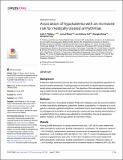Association of hypokalemia with an increased risk for medically treated arrhythmias
Author(s)
Phillips, Colin T.; Wang, Junmei; Celi, Leo Anthony G.; Zhang, Zhengbo; Feng, Mengling
DownloadPublished version (962.3Kb)
Terms of use
Metadata
Show full item recordAbstract
This is an open access article distributed under the terms of the Creative Commons Attribution License, which permits unrestricted use, distribution, and reproduction in any medium, provided the original author and source are credited. Background Potassium replenishment protocols are often employed across broad patient populations to prevent cardiac arrhythmias. Tailoring potassium thresholds to specific patient populations would reduce unnecessary tasks and cost. The objective of this retrospective cohort study was to determine the threshold at which hypokalemia increases the risk for medically treated arrhythmias in cardiac versus medical and surgical intensive care units. Methods Patients captured in the publicly available Philips eICU database were assessed for initiation of either intravenous amiodarone, adenosine, ibutilide, isoproterenol, or lidocaine as a surrogate for a clinically significant arrhythmia. A landmark time-to-event analysis was conducted to investigate the association of serum potassium values and time-marked administration of an antiarrhythmic drug. Analysis was adjusted for comorbidities, the use of vasopressor agents, diuretics, as well as age, gender and severity of illness. Results Among 20,665 admissions to cardiac intensive care units, 1,371 (6.6%) were treated with either amiodarone, adenosine, ibutilide, isoproterenol, or lidocaine. For potassium values of 3.0<3.5mEq/L, antiarrhythmic treatment occurred at an increased rate compared to a baseline of 4.05.0mEq/L (HR 1.23, 95% CI 1.01–1.51; P = 0.04). For admissions to medical and surgical intensive care units, 2,100 of 69,714 patients (3.0%) were treated with either amiodarone, adenosine, ibutilide, isoproterenol, or lidocaine. Potassium values of 3.0<3.5mEq/L were also associated with an increased hazard of treatment (HR 1.26, 95% CI 1.09–1.45; P = 0.002). In both cohorts, worsening hypokalemia was associated with an increased risk of antiarrhythmic drug treatment. In neither cohort were there statistically significant differences for serum potassium values of 3.5<4.0 and a baseline of 4.05.0mEq/L. The proportion of patients initiated on vasopressors or inotropes was over four-fold higher in those treated with one of the antiarrhythmic drugs in both cohorts. Conclusions Serum potassium levels <3.5mEq/L were associated with an increased hazard for treatment with specific antiarrhythmic drugs in a large cohort of patients admitted to both a cardiac as well as medical and surgical intensive care units. Potassium thresholds may be individualized further based on risk of relevant outcomes.
Date issued
2019-06Department
Massachusetts Institute of Technology. Institute for Medical Engineering & ScienceJournal
PLoS One
Publisher
Public Library of Science (PLoS)
Citation
Phillips, Colin T. et al. "Association of hypokalemia with an increased risk for medically treated arrhythmias." PLoS ONE 14, 6 (June 2019) : e0217432 © 2019 Phillips et al.
Version: Final published version
ISSN
1932-6203